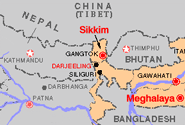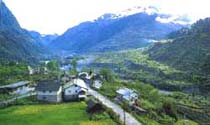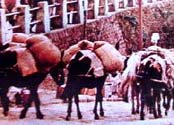|
 Kolkata: The recent inking of the agreement for expanding cross-border trade between India and China through the Nathu La Pass in Sikkim, as a fallout of the recent six-day visit of Indian Prime Minister A B Vajpayee, is seen as an impetus for ushering in regional development in Southeast Asia. Kolkata: The recent inking of the agreement for expanding cross-border trade between India and China through the Nathu La Pass in Sikkim, as a fallout of the recent six-day visit of Indian Prime Minister A B Vajpayee, is seen as an impetus for ushering in regional development in Southeast Asia.
Economic development so far has remained elusive to the sub-region and the flourishing of trade along this route could well create a new trade bloc in Asia outside the Association of Southeast Asian Nations region, feel experts. Indian Chamber of Commerce secretary-general Nazeeb Arif, who is an expert in the economic development of this sub-region, says: "The easing of political tensions along this route and the consequent opening of this strategic path have paved the way for unprecedented economic development in the region. This includes the Greater Mekong region of Laos, Cambodia, Vietnam, Thailand, eastern and north-eastern states of India, Bangladesh, Bhutan, and the Yunan province of China. The Nathu La pass will provide the key connectivity to develop that trade bloc." He suggests that the creation of such a trade bloc will pave the way for further economic cooperation between the two Asian economic giants. "India and China can now work on their synergies for effective partnership that could be a formidable economic rival to the European Union and the North American Free Trade Agreement." The economic effects of the opening of the new trade route are fivefold: - Flourishing two-way trade: The north-eastern states and indeed the eastern states of India could tap the Chinese market for their products and look at it as a more effective land route. This must be done instead of being overtly concerned by the import of cheap Chinese goods. In this, the states must leverage their own strengths.
- India a new sourcing point for intermediary products, which could feed the Chinese factories for production of manufactured goods. For example, Haldia Petrochemicals, which produces the raw material for polymers and plastics industries, could emerge as a ready sourcing point for manufacturers of plastic goods in China.
- Fillip to agro exports: Here is a region rich in agricultural produce. Eastern India has five agro-export zones and the one in the north-east in Tripura, which has a whole new market, could be accessed and agro and agri-processed food sold.
- Accessing third markets: Partnerships and joint venture collaborations could help in accessing third country markets such as Taiwan, Indo-China, Japan and Korea by utilising the Chinese export marketing network.
- Tourism could thrive in this region with land routes readily available. This could be developed into an integrated international tourist circuit. The region is, no doubt, picturesque.
The region when seen in perspective by investors could seem a very profitable proposition, adds Arif.  However, with the political will in place, the next step is to carefully tap the economic opportunities that have emerged. For starters, the state governments must be urged to commission studies as to how this region has to develop in an integrated manner. According to the agreement, India and China have decided on two trading hubs - Tsomgo in Sikkim and Rinchingang in Tibet. However, with the political will in place, the next step is to carefully tap the economic opportunities that have emerged. For starters, the state governments must be urged to commission studies as to how this region has to develop in an integrated manner. According to the agreement, India and China have decided on two trading hubs - Tsomgo in Sikkim and Rinchingang in Tibet.
Sikkim, which would be the direct beneficiary of this cross-border trade agreement, had been lobbying over a length of time with New Delhi for resumption of border trade. With the agreement in place, the Sikkim government is keen on a rapid implementation of the agreement and not allow it to be trapped in the usual delays. While Sikkim is anxiously waiting for the agreement to be worked out, West Bengal is looking forward to the growing importance of Bagdogra airport in Darjeeling and hope that it may be upgraded to an international one. This would lead to the emergence of North Bengal as an additional trading point with China. While all these visions for integrated development are yet to be worked out and the euphoria for a better economic future is being felt, there is a degree of sobriety that is being felt at the government quarters. The government will have to be more alert and proactive because the opening of the new route means movement of people across borders, bestowing on the state government the responsibility of monitoring the flow of people. Enormous trading activities with transportation might affect the fragile and pristine environment in an adverse manner. The new scenario will have to be a modern one with heavy vehicles moving about the place - a far cry from the tinkling bells of the mule trains carrying exotic products of commerce through the thin mountain air. Trade through this region has a chequered history. With the occupation of Tibet by China in the early 1950s, trade got a major fillip as the Chinese, who were on a construction overdrive, asked the Tibetans to bring in more construction material. However, with the souring of the Sino-Indian relations and the subsequent war in 1962, all trade along this route had abruptly stopped.  Forty-one years ago, the trail of the mule trains was picturesque and interesting. Tibetan traders, with their mules laden with 2 maund (80 kg) sacks of musk pods, raw Tibetan sheep wool, silk, brocade, zee (precious Tibetan stones) and dayangs (Chinese silver coins), would arrive at Gangtok, the capital of Sikkim from Lhasa, the Tibetan capital, which is 425 km north-east of Gangtok. They would descend from the icy Nathu La pass, which is 14,000 feet above sea level. Forty-one years ago, the trail of the mule trains was picturesque and interesting. Tibetan traders, with their mules laden with 2 maund (80 kg) sacks of musk pods, raw Tibetan sheep wool, silk, brocade, zee (precious Tibetan stones) and dayangs (Chinese silver coins), would arrive at Gangtok, the capital of Sikkim from Lhasa, the Tibetan capital, which is 425 km north-east of Gangtok. They would descend from the icy Nathu La pass, which is 14,000 feet above sea level.
The merchandise would be unloaded, and the mules rested and fed. Trading would begin soon after and haggling began. All goods were sold by weight. In exchange they would buy, manufactured consumer goods, ranging from biscuits to motor vehicles in knocked-down form, from Indian businessmen who had gathered at Chandmari ground in the upper reaches of Gangtok. Trading over the return journey would commence. Indian traders were issued permits only till Yathung about 15 km into Tibet - or the major trading post of Gyantse. The first stop is either Chhangu Lake or Sherathang. The next would be down the mountain at Chubithang about 4 km from Nathu La. Yathung is the first major Tibetan trading post. The rest of the trail passes through the undulating Tibetan plains with no sign of any vegetation. The descent into Chumbi Valley on the route down from Nathu La to Yathung is breathtaking. It is now up to the individual governments to script a new success story for the future; they must realise that the road to economic success is self-driven. A whole new world of opportunities awaits businessmen. The spadework, however, needs to be done in an expeditious manner. © 2002 Asia Times Online Ltd. This article first appeared on www.atimes.com, and is republished with permission
|